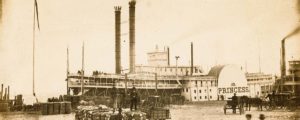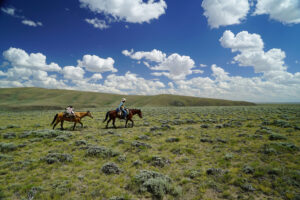Once a trusted trader, he turned to building a town.
Dutch Bill Greiffenstein lost his young Cheyenne wife before the November 1868 Battle of the Washita and a young fortune afterward when Lieutenant Colonel George Custer killed some of his best customers and Greiffenstein himself was forced to beat it out of Indian Territory under threat of hanging. A few years later, he was one of the founders of Wichita, Kansas, destined to be the biggest city in the state. Two decades after that, he pulled strings to make sure his three children—threequarters German and one-quarter Indian —would be listed on the tribal register for whatever semblance of a safe income the troubled nation could provide. Greiffenstein’s life was sometimes arduous, sometimes tragic, sometimes heroic and seldom if ever boring.
Dutch Bill started out respectable. He was born Wilhelm Greiffenstein on July 28, 1829, near Darmstadt in western Germany, Hessian country that was becoming Prussian country. His father, Carl Greiffenstein, a senior civil servant, landowner and pillar of the Lutheran Church, sent him to the Darmstadt Gymnasium (a high school/junior college). There, students read Plato and Cicero in the original Greek and Latin and prepared for a university education of drinking, dueling and gambling. Falsely implicated in the March Revolution of 1848, Wilhelm skipped the university and made his way to the United States as a teen fugitive from injustice.
Well versed in Greek, Latin, and German and learning English, Greiffenstein headed for St. Louis—a largely German city since the days when the French imported hardworking German settlers to Louisiana—and took on a series of clerical jobs. But within two years, he was working as a trader, first with the Shawnees and Delawares in Kansas, later with the “wild” tribes of Indian Territory —Kiowas, Comanches, Arapahos and Southern Cheyennes. Nature-loving German Romantic that he was, Greiffenstein reveled in the frontier. His fate was cast when he met the tall, beautiful Indian girl later known as “Cheyenne Jennie,” who became his wife and, in an utterly vital sense, his business partner. With Jennie’s help, Greiffenstein (sometimes Americanized to Griffenstein) actually learned to speak a modicum of Cheyenne, a maddeningly difficult Algonquian language, though Jennie remained a critical interpreter. Through the 1850s and early 1860s, Dutch Bill traded with the Indians, advised by Jennie on what the Indians actually wanted to buy and protected by the fact that Cheyennes disliked killing their in-laws. After Sand Creek, some of Jennie’s relatives dropped in to advise Greiffenstein it was open season on white people. Taking the hint, he relocated to Fort Cobb.
The November 1864 slaughter at Sand Creek and the advance of the railroads sent those Cheyennes who couldn’t accept their doom on a rampage of murder, rape and kidnapping. Jennie had already been infected with tuberculosis (“the coughing sickness,” a bane of those Indian girls who cohabitated with whites), but she helped Greiffenstein ransom captives of the warrior tribes and maintain the fragile peace. When Cheyenne raiders kidnapped Clara Blinn and her little boy, Willie, from Colorado Territory in the fall of 1868, Cheyenne Jennie set out to ransom them as she had earlier rescued white children kidnapped by the Comanches. Colonel William Babcock Hazen, an honorable officer who deplored the cheating of Indians by crooked traders, took due note of Dutch Bill and Cheyenne Jennie as humanitarians and peacemakers. “Too much cannot be said in praise of ‘Cheyenne Jennie,’ wife of Wm. Griffenstein,” wrote Hazen, “for the interest she took and exertion she made in recovering the captive children from the Comanches, visiting their camps, invalid as she was, riding in her ambulance when she was not able to sit up, giving up her own horses for the McElroy children that they might go home with their father.”
Jennie died in the midst of negotiations to ransom Clara and Willie Blinn. “She was a fine woman,” observed the half-Cheyenne trader George Bent. “She did more good work in fostering peaceful relations between the Indians and the whites than many an official or high commissioner sent out by the government.” A devastated Greiffenstein returned Jennie’s body to her relatives for a proper burial. While he was en route, Custer fell on the Washita like a thunder bolt out of a snowstorm, killing guilty and innocent Indians alike. Clara and Willie Blinn died among the Indians— killed by vengeful Cheyenne women or stray trooper bullets. Greiffenstein, emboldened by his idealistic notions of American justice, reportedly told Maj. Gen. Philip Sheridan the attack on the Washita was cold-blooded murder. Charging Greiffenstein with selling munitions and food to the Indians, Sheridan revoked his trader’s license and threatened him with hanging if he stayed in Indian Territory. Greiffenstein headed back north to Kansas.
Greiffenstein’s classical education may have taught him the finer points of marital diplomacy. On November 21, 1869, he married Catharine Burnett. Her mother was Mary Knoffloch, a German, and her father was Abram Burnett, a Pottawatomie chief of legendary physical strength and great political influence. Abram, who weighed 465 pounds, once contested the role of strongest Pottawatomie with a fellow tribesman who weighed a mere 400 pounds. His rival lifted the heaviest rock he could budge; Abram allegedly lifted the rock and his rival at the same time. Abram won.
Supported, as it were, by his formidable father-in-law, Greiffenstein opened a store in Kansas. Recognizing enormous promise in the site of Wichita, he and associates James Mead and J.S. Munger obtained title to the land, using paper bags from his store to register the documents, and then began to sell off the building lots. He made good money on the lots, but his masterpiece was the bridge over the Arkansas River. Before the 1872 bridge, cattle had to be driven across to sink or swim. Greiffenstein and Mead chipped in with others to build a 1,000-foot 10-span bridge resting on iron piles, with stone piers and abutments, a 16-foot roadway and tollhouse at each end. The structure cost $29,000, but the tolls eliminated that debt in a short time: Two-horse or two-mule teams paid 50 cents each; four-horse or four-mule teams paid 75 cents; six-horse or six-mule teams with a wagon paid $1; a horse and buggy paid 25 cents; the first yoke of oxen cost 50 cents, and each additional yoke was 10 cents. A man on horseback paid 15 cents and a man on foot paid 5 cents. Cattle paid 5 cents each, sheep and hogs 2 cents each. The bridge was so successful in creating a thriving Douglas Avenue commercial center that in 1874 the county commissioners bought it for $6,400—after the owners had operated at a profit for years.
Soon elected mayor of the town he helped found, Greiffenstein presided over Wichita’s early growth. “Greiffenstein’s time, from 1878 to 1885, were glorious, triumphant years,” one old settler noted. “He was almost alone in his labors. The wealth and power of Wichita was against him.…Greiffenstein was not a snob, nor an aristocrat. He was plain, simple and honest in all his dealings. I have no recollection of his ever wearing a collar or having his vest buttoned up.…He said to me one day, ‘Call me Bill; I do not like to be called Mister.’ …He was an oracle to his followers.”
Greiffenstein took so much paternal pride in Wichita that he leased offices free to tenants whom he thought could do the town some good. But he also made sure his three children with Catherine had a solid education, including piano lessons. A church service was held in his home. He built a hotel, was a partner in the streetcar company and several banks and owned a ranch on Pottawatomie land with more than 1,000 horses and 3,000 head of cattle.
Greiffenstein took a hit in the mini-recession of 1889, losing money on the construction of a watch factory that failed to produce a single watch. The big hit came with the national recession of 1893. Seriously overextended, he sold all his Wichita holdings at a loss to avoid the humiliation of debt and removed to Indian Territory with Catherine and the children, who were duly enrolled as members of the Pottawatomie Tribe.
Dutch Bill’s visionary and honest administration had started Wichita on the right foot. His reputation among the Indians as a trustworthy white man provided a safety net for his family once the investments caved in. He died on September 26, 1899, at Burnett, Indian Territory, now part of Oklahoma City, but his body was reinterred at Highland Cemetery in Wichita—the town he helped build after the Washita destroyed his first frontier enterprise.
Minjae Kim assisted with research. Thanks also to the Kansas State Historical Society.
Originally published in the February 2010 issue of Wild West. To subscribe, click here.




